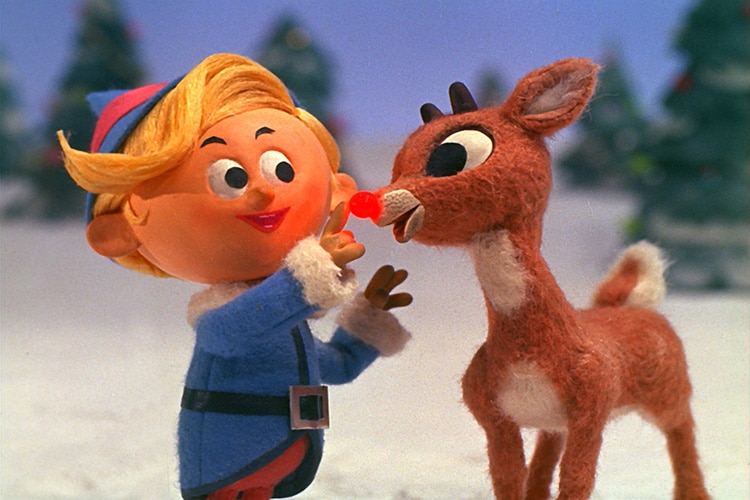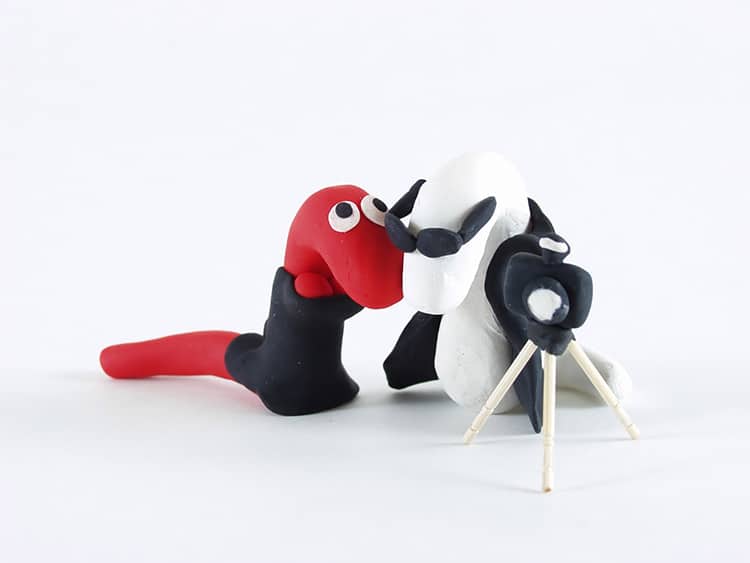
Rudolph and Hermey in the 1964 TV special. (Photo: Rankin Bass, Public domain)
Have you ever drawn a series of stick figures on the edges of a pad of paper? As you flip through the pages, the figure appears to run, jump, or move in some way. This is the theory behind all filmmaking; it’s a series of similar images that, when shown in rapid succession, trick the eye into seeing motion. Animators draw thousands of frames, and film strips capture individual images compiled into reels.
Some films combine art and photography in a technique known as stop-motion. Through this approach, sculpted figures or puppets are arranged and slowly moved for a series of photographs for amazing animated effect. When the characters are made of clay, the technique is commonly known as claymation.
Read on to learn about the history of stop motion and how you can make your own.
Early Stop-Motion Films
The early days of filmmaking were experimental by necessity. Animators used cel animation, the standard illustrative technique employed by creators such as Disney, until the advent of computers. Clay figures were sometimes incorporated into works featuring live actors or two-dimensional illustrations. In the first two decades of the 19th century, filmmakers also created the first full claymation short films. Most have been lost to time, but these early works played on the very novelty of claymation with names such as Sculpteur Moderne and Miracles in Mud.
The oldest complete and extant claymation short film is entitled Long Live the Bull. Created by Joseph Sunn and released in 1926, this silent, black-and-white film tells a love story set in Barcelona. The roughly-sculpted main character—named Bologna—woos his lady. However, she requests that he fight a bull to prove his love and bravery. In collusion with a friendly bull, the amateur matador puts on a show to claim his lady’s heart. Though just under fifteen minutes long, the tale is an excellent example of the painstaking effort put into the earliest works of claymation.
The Golden Age of Claymation
The middle of the 20th century saw the rise of several famous claymation characters that are still recognizable today. Artistic pioneer Arthur Clokey modeled a green, block-like character with vivid cartoon features. Known as Gumby, the character was given wide feet to stand up during filming and a pony sidekick named Pokey. This strange figure debuted in 1955 on The Gumby Show, a children’s program which continued to run throughout the 1960s. Gumby has since been revived countless times on television and film.
Rudolph the Red-Nosed Reindeer is another classic stop-motion film that debuted on television in 1964. The special was created by Rankin/Bass Productions at the MOM Productions studio in Tokyo. Animator Tadahito Mochinaga and production director Arthur Rankin, Jr. brought their talents together to create the 55-minute film. The dynamic duo developed what was known as “animagic“: a stop-motion technique using puppets that were slowly moved for each image. The puppets for the films were made of woods, wires, and wool (as opposed to clay). However, the technique of subtly posing and maneuvering each character between frames is much the same as in claymation.
New Technologies for a Traditional Approach
Stop-motion filmmaking techniques have been used in modern masterpieces. Nick Park, a British animator, created the popular series Wallace & Gromit. The first short film debuted in 1989 featuring a lovable inventor and his loyal pup. Created from plasticine, the moldable figures were posed between frames. Special techniques—such as creating motion blur—were used for dramatic effect. A 2005 full-length film featuring the duo took an ambitious step. To achieve flames and floating bunny characters, some scenes combined stop-motion characters with traditional animation. The team went to great lengths to blend the two methods of storytelling into one indistinguishable whole.
Park, with Peter Lord, also directed the most commercially successful stop-motion film ever, Chicken Run (2000).
Moving beyond clay and puppets, 3D printing has allowed animators to create interchangeable parts and highly intricate figures— as seen in stop-motion projects such as the film Coraline. Directed by Henry Selick, the film used 150 miniature sets and 28 animators. By printing new parts, the character of Coraline could make over 200,000 faces. But even with these resources, stop-motion techniques make for slow-going progress at about 100 seconds of storyline produced each week.
Like Coraline, modern classics such as the Corpse Bride and The Boxtrolls have redefined what is artistically and commercially possible with stop-motion techniques.
Making Your Own Stop Motion Film

Photo: YAYIMAGES/Depositphotos
While most people do not have the design expertise and resources to pull off a film like Coraline, making your stop-motion film is surprisingly easy and fun. You can sculpt your own characters out of clay available at any art store. However, you can also use dolls, posable stuffed animals, or even human friends to create your film.
Think of a story first. It may be helpful to create a rough storyboard to work from. Then, shoot frames with your phone or digital camera, ideally on a tripod. Keeping the frame stable is important. The characters should move subtly in each frame unless they are meant to stand still. Once you’ve captured your frames, use simple video software to “flip” quickly through the shots. You will have created your own work of film history for all to enjoy.
Learn how to make your own stop-motion animation in the video below.
Related Articles:
Technicolor: The Vibrant History of Hollywood’s Early Introduction to Color Films
The Original Photo That Inspired the Iconic Columbia Pictures “Torch Lady” Logo
Actor Gary Sinise Shares Incredible Photos From the Set of “Forrest Gump”
20 Gifts Movie Lovers and Film Buffs Will Love and Actually Use
